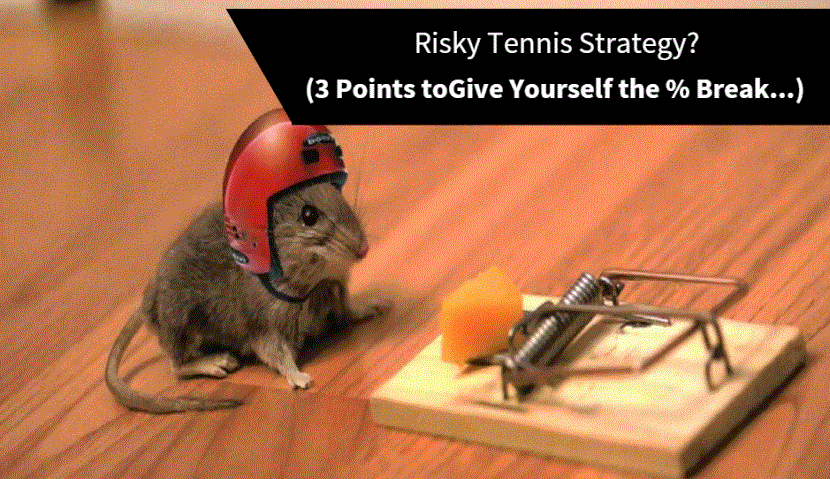It’s said that 95% of new traders lose, but is your tennis strategy very risky?
Risk often comes from not knowing what’s going on. Or being consciously aware at least…
Trading the tennis this week has inspired me to share these #3 important points.
Why Stop Losses Won’t Help You…
New traders are often seen talking about stop-losses and stop-loss functions within the various trading forums. My opinion is they’re all but pointless anyway. Tennis is no different.
In fact I can’t think of a tennis strategy that would use a stop-loss, or why. Maybe if you were placing a small trade, pre-match, and off to walk the dog or something? I don’t know.
Tennis is wildly different to the likes of horse racing trading, and so you need a different strategy. Once a match goes in play, price movements become somewhat ‘mechanical’. Due to the nature of the game, and all the court-siders, it’s easier for the big boys to model.
In-play tennis strategies often evolve around the break in serve…
Just another reason stop-losses are useless in tennis. Between the points where a price settles, the market is extremely illiquid. Meaning even if your stop-loss is triggered, it’s unlikely to be matched at the active price just rocketed through it. This is also a reason I don’t see the point of them in horse-racing markets. The whole idea of stop-losses have been carried over from a financial trading environment in my mind. Nothing more.
If anyone’s found a real good, reliable use for them, I’d be keen to hear how… let me know in the comments!
Finally; a good tennis strategy will have clearer points of entry and exit unlike other markets. So, before you enter a trade it’s likely you have a good idea of the intended exit. If that’s the case, why use a stop-loss?
What Risk Ratio Are You Taking? 50%?
Risk; it’s not why we do this…

…or at least it shouldn’t be.
The last point from the first paragraph is important. Very important when building a tennis strategy to implement.
Firstly; lets keep it real. You can’t win all the time, trading is not about winning all the time, it’s about winning more often than you lose.
Tennis is a 50-50 game, there’s two players, which is why so many are drawn to it I’m sure. But what angle are you going for?
Are you looking to be right 50% of the time, but with a larger upside each time you win. or Are you looking to win more often than not, but gain a minimum of 50% on each trade?
Bearing in mind your risk v’s reward ratio is really important. Without it, it’s unlikely your tennis strategy will ever be successful. Sure, it’s possible to trade in-play based on player and tennis knowledge. But when you think about it, that’s a way of skewing that ratio in your favour (more-so for the tennis guru’s amongst you).
The biggest danger is when you don’t know where you intend to open and or close…
Without It You May-As-Well Quit Now…
Every week I get at least 3 people email me with the same problem. The irony being; by the time they’ve finished writing the email they have usually answered their own question.
It’s one of those suck-it-up problems. And nobody likes the honest answer…
Self-control is your responsibility. There’s plenty of pointers and tips to help out, but at the end of the day the buck stops with the individual. If you can’t keep to the tennis strategy you’ve devised, or any sport for that matter, there literally is no point!
None, nada.
I think my generation are particularly bad for this, and I’ve done it in the past. I’m not perfect. But seeking to blame irrational, unplanned, gambling-style behaviour on anything else isn’t ever going to achieve the results you or I want. It’s just reality.
Discipline is paramount in your tennis strategy. Black or white, it has to happen. With the large swings in price, you can’t afford to hold on a little bit longer. In comparison horse racing trading is a little more forgiving (pre-race) as you’re only likely to lose a tick or two though a hesitant decision. With tennis it’s going to be a lot more, which hurts.
Earlier in the week I was a little slow to react myself. Granted I just took the loss and it wasn’t exactly bad, but it left me feeling a bit disjointed. You need to be aware of the effect I’ll discipline can have on later trading too. In the instance I refer to I took a short break afterwards, why?
Because by breaking the emotional cycle (quite literally) is the best way I know to re-centring my mindset. Who care’s if I missed an opportunity. It meant I didn’t make further bad decisions. Imagine if only you could measure the ROI in doing that hey? I bet a few of you would be gob-smacked at the impact it’s had on your results over time.
Top Tennis Article: 3 Tennis Trading Strategies for Betfair…


2 thoughts on “Risky Tennis Strategy? 3 Points to Give Yourself the % Break…”
Hi Caan,
Wallygog here. A virgin newbie. Will obviously leave tennis alone, until I’ve done my time in Pre-race horse racing. Interesting article and good to hear expert views. Many thanks
Another well-written article Caan, what really has hit home to me here is that I’m not getting enough out of my trades .even when doing everything right the numbers need to be right. I wasn’t getting enough upside.I was risking 10 and gaining 10 .the problem here is I wouldn’t be right enough times so Id eventually bust my bank by getting frustrated and annoyed.